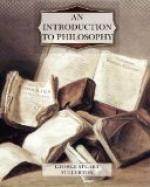But what shall we say of his claim that the tree is really green, and only looks blue under certain circumstances? Is it not just as true that the tree only looks green under certain circumstances? Is color any part of the touch thing? Is it ever more than a sign of the touch thing? How can one color be more real than another?
Now, we may hold to Berkeley’s analysis and maintain that, in general, the real world, as contrasted with the apparent, means to us the world that is revealed in experiences of touch and movement; and yet we may admit that the word “real” is sometimes used in rather different senses.
It does not seem absurd for a woman to Say: This piece of silk really is yellow; it only looks white under this light. We all admit that a white house may look pink under the rays of the setting sun, and we never call it a pink house. We have seen that it is not unnatural to say: That tree is really green; it is only its distance that makes it look blue.
When one reflects upon these uses of the word “real,” one recognizes the fact that, among all the experiences in which things are revealed to us, certain experiences impress us as being more prominent or important or serviceable than certain others, and they come to be called real. Things are not commonly seen by artificial light; the sun is not always setting; the tree looks green when it is seen most satisfactorily. In each case, the real color of the thing is the color that it has under circumstances that strike us as normal or as important. We cannot say that we always regard as most real that aspect under which we most commonly perceive things, for if a more unusual experience is more serviceable and really gives us more information about the thing, we give the preference to that. Thus we look with the naked eye at a moving speck on the table before us, and we are unable to distinguish its parts. We place a microscope over the speck and perceive an insect with all its members. The second experience is the more unusual one, but would not every one say: Now we perceive the thing as it is?
21. ULTIMATE REAL THINGS.—Let us turn away from the senses of the word “real,” which recognize one color or taste or odor as more real than another, and come back to the real world of things presented in sensations of touch. All other classes of sensations may be regarded as related to this as the series of visual experiences above mentioned was related to the one tree which was spoken of as revealed in them all, the touch tree of which they gave information.
Can we say that this world is always to be regarded as reality and never as appearance? We have already seen (section 8) that science does not regard as anything more than appearance the real things which seem to be directly presented in our experience.
This pen that I hold in my hand seems, as I pass my fingers over it, to be continuously extended. It does not appear to present an alternation of filled spaces and empty spaces. I am told that it is composed of molecules in rapid motion and at considerable distances from one another. I am further told that each molecule is composed of atoms, and is, in its turn, not a continuous thing, but, so to speak, a group of little things.




